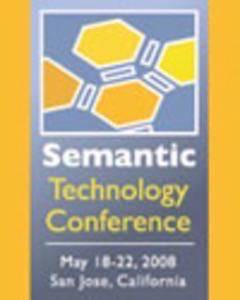How will the Semantic Web make the jump to the mainstream? That was the topic of a panel at the SemTech 2008 Conference that is going on right now in San Jose. The panel was moderated by Carla Thomson from Guidewire Group and featured Josh Dilworth from Porter Novelli,
Tom Tague, who heads the Calais initiative at Reuters, and Mark Johnson, who is a product manager at Powerset.
This post is based on notes from that panel.

Problems with Semantic Web Marketing
The panel began with a discussion of the mainstream and the Semantic Web. Everyone agrees that there is a big need to simplify messaging to the masses. Marketing the Semantic Web to consumers does not make sense because they don’t care about technical specifics. People do not need to know about RDF and Microformats, what they are looking for are simple and tangible benefits that make their lives on the web easier.
Carla points out that we need to invent new terminology to describe
the transformation and the new technologies that are being developed. She suggests
to use the term “Smarter Web.” This is a new web where people can find things
that they are looking for faster, and experience more intelligent, contextual interactions with the vast amount of information out there.
What is the Killer App?
The discussion shifts from what is wrong with Semantic Web marketing to
what is the “killer app” for the Semantic Web. Tom Tague says there is no killer app,
and there really can’t be. He thinks of semantic technologies as the spice, the infrastructure that will give rise to a family of semantic web applications. Tom argues
that what we are seeing is pieces being brought slowly to market,
which make search incrementally better, make browsing incrementally better, etc.
Naturally, the discussion shifts to the impact on Google. For better or worse,
people expect the killer app for the Semantic Web to be a Google killer as well.
As an example, after the recent launch of Powerset it has been constantly compared to Google. [Including on this blog — Ed.] Mark Johnson points out that this is not reasonable, because Powerset is simply not yet there — right now it can only search Wikipedia.
So coming full circle to Tom’s point, if we’re only going to get incremental improvements, the question is then how much effort is warranted. This is not
a minor point given that the bar is set high because companies themselves and the media are creating lots of hype around the Semantic Web.
PR and Hype Around the Semantic Web
The goal of Powerset, for example, is to change the way that people
interact with computers. Carla points out that marketing that claims large goals,
like to change human-computer interactions, is quite ambitious. Maybe this messaging needs to be
incremental just like the progress that is being achieved. As an example of adjustment in messaging,
Carla suggests that it could simply be: Powerset today provides a better way of searching information
in Wikipedia. As more tools are get rolled out, the messaging can adjust, and then once all the
bits are in place, switch to the messaging about changing the way that people interact with computers.
An interesting twist to the whole conversation is the need for larger Semantic Web players to justify longer terms plans. Powerset, for example, is a 60 person company with > 20 employees that have PhDs in computational linguistics. Venture capitalists don’t want to hear that all the company will do is to change the way
that people search Wikipedia. So Powerset has been forced to justify a longer run and bigger staff by putting broader goals on the map.
Further, the messaging tool is the media, which is becoming increasingly more hype-based.
Companies are being provoked to describe their broader vision, to appear big and ambitious in order to get
coverage. So there is a conflict between market messaging, investor messaging and a realistic,
long term plan to deliver semantic technologies to the market.
Ease of Use
Beyond marketing, everyone agrees that if semantic technologies can deliver
tangible consumer benefits, then marketing problems will not be as acute. It is
the tension between loud marketing and the modest forward progress being made that is leaving everyone underwhelmed.
And so, the panel agrees that Semantic Web companies need to pay more
attention to the user experience, and to ease of use in particular. Tom Tague
says that people don’t care what is underneath. Infrastructure does not
excite people, but UI does.
Conclusion
Panelists agreed that despite the challenges, companies are making
definite progress. They also agreed that it would be good to tone down
marketing, remove the grandiose Semantic Web slogans, and focus on specific consumer utility.

















